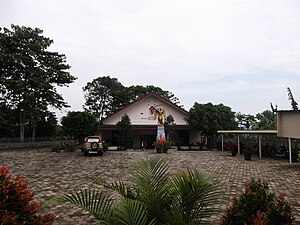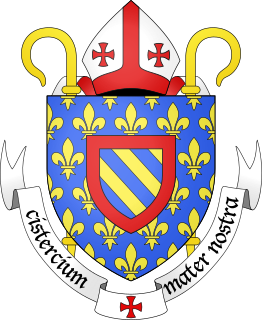
The Cistercians officially the Order of Cistercians, are a Catholic religious order of monks and nuns that branched off from the Benedictines and follow the Rule of Saint Benedict. They are also known as Bernardines, after the highly influential Bernard of Clairvaux ; or as White Monks, in reference to the colour of the "cuculla" or white choir robe worn by the Cistercians over their habits, as opposed to the black cuculla worn by Benedictine monks.

New Melleray Abbey is a Trappist monastery located near Dubuque, Iowa. The abbey is located about 15 miles southwest of Dubuque and is in the Archdiocese of Dubuque. Currently the Abbey is home to about 28 monks. Several of the monks work in their business, Trappist Caskets, and some of their food comes from the garden behind the Abbey. The abbot of the monastery is Dom Mark Scott, who was elected by the community for a 6-year term on July 15, 2014.
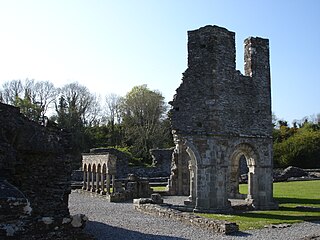
Mellifont Abbey, was a Cistercian abbey located close to Drogheda in County Louth, Ireland. It was the first abbey of the order to be built in Ireland. In 1152, it hosted the Synod of Kells-Mellifont. After its dissolution in 1539 the abbey became a private manor house. This saw the signing of the Treaty of Mellifont in 1603 and served as William of Orange's headquarters in 1690 during the Battle of the Boyne.

The Monastery of the Holy Spirit, officially the Monastery of Our Lady of the Holy Spirit, is a Trappist monastery located near Conyers, Georgia.

Our Lady of Bethlehem Abbey, a Cistercian monastery in Portglenone, County Antrim, Northern Ireland, was founded in 1948 by Mount Melleray Abbey in County Waterford. The monks bought Portglenone House, a country mansion built about the year 1810 by the Church of Ireland Bishop, Dr. Alexander who demolished the local castle. History records that Sir Roger Casement often stayed in the house in the early years of the 20th century.

The Abbey of Our Lady of the Mississippi is located near Dubuque, Iowa. The nuns there are members of the branch of the Order of Cistercians of the Strict Observance, commonly referred to as Trappistines. They are a part of the Catholic Church in the Archdiocese of Dubuque.
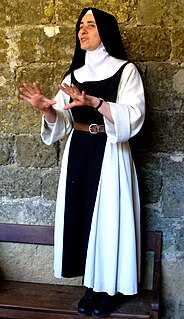
Cistercian nuns are female members of the Cistercian Order, a religious order belonging to the Roman Catholic branch of the Catholic Church.

Nunraw Abbey or Sancta Maria Abbey, Nunraw is a working Trappist monastery. It was the first Cistercian house to be founded in Scotland since the Scottish Reformation. Founded in 1946 by monks from Mount St. Joseph Abbey, Roscrea, Ireland, and consecrated as an Abbey in 1948, it nestles at the foot of the Lammermuir Hills on the southern edge of East Lothian. The estate of the abbey is technically called White Castle after an early hill-fort on the land.
Notre-Dame de l'Assomption Abbey is a Trappist/Cistercian monastery located in Rogersville, New Brunswick, Canada.
Brecht Abbey, also known as the Abbey of Our Lady of Nazareth, is an abbey of Trappistine nuns located in Brecht, in the Campine region of the province of Antwerp. Life in the abbey is characterized by prayer, reading and manual work, the three basic elements of Trappist life.
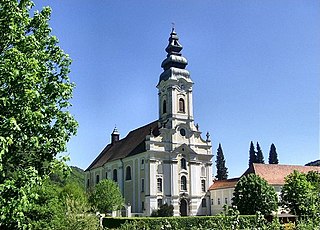
Engelszell Abbey is a Trappist monastery, the only one in Austria. It is located near Engelhartszell an der Donau in the Innviertel in Upper Austria.
Saint Mary's Abbey, Glencairn is a monastic community of nuns located in Glencairn, County Waterford, in Ireland. The community belongs to the Trappist branch of the Cistercian order, thus the nuns are also referred to as Trappistines. The original community of this monastic tradition had been welcomed to Ireland by St. Malachy in 1142. The monastery was founded in 1932 by nuns of Holy Cross Abbey—located at that time in Stapehill, Dorset, England—which itself had been founded in 1802 by a small group of refugee nuns from France, led by a nun who had been imprisoned in the Bastille during the French Revolution, and narrowly escaped being sent to the guillotine. The land for the St Marys Abbey, had been bought for them by the Cistercian Mount Melleray Abbey. The monks from Mount Melleray used to operate the farm.

The Abbey of Our Lady of the Holy Trinity was a Trappist Cistercian monastery in Huntsville, Utah, United States. They were Roman Catholic contemplative monks of an enclosed religious order known as the Order of Cistercians of the Strict Observance (OCSO).

Igny Abbey or Val d'Igny Abbey is a Cistercian abbey located in Arcis-le-Ponsart, Marne, France. It was founded in 1128 for Cistercian monks, dissolved in 1791 during the French Revolution, re-established in 1876 for Trappist monks, destroyed in 1918, reopened in 1929 for Trappist nuns and modernised in 2008–12 to accommodate three or four pre-existing communities.

Mariastern Abbey is a Trappist abbey in Bosnia and Herzegovina, situated near the country's second largest city Banja Luka. It consists of the Church of the Assumption of the Blessed Virgin Mary and the monastery of Trappist monks. It is the only Trappist monastery in Southeastern Europe. At the beginning of the 20th century, with 219 monks, the Abbey was the largest Trappist abbey in the world; today it is the smallest, with only two monks.

Koningshoeven Abbey is a monastery of the Trappists founded in 1881 in Berkel-Enschot in North Brabant, the Netherlands.
Fransiskus "Frans" Harjawiyata O.C.S.O. was an Indonesian Roman Catholic monastic abbot and member of the Order of Cistercians of the Strict Observance, who are more commonly known as the Trappists. Harjawiyata, who was the first Indonesian-born Trappist abbot in the country's history, headed the St. Mary's of Rawaseneng Monastery in Temanggung Regency, Central Java province, from 1978 to 2006. Harjawiyata is credited with helping to develop Christianity in Indonesia by translating Catholic scriptures and chants into Indonesian. He translated the Breviary from Latin into Indonesian, authored several books on spirituality, and composed several Indonesian-language Gregorian chants. His chants are still performed in Catholic churches throughout Indonesia today.
Bunda Pemersatu Monastery is a monastery complex of the Catholic Order of Cistercians of the Strict Observance (O.C.S.O.), popularly known as the Trappists, located in Semarang Regency, Central Java, Indonesia. The monastery was officially established on the Palm Sunday 12 April 1987 as a daughter house of Rawaseneng Monastery in Temanggung Regency. Its architecture was one of the works of Fr. Y. B. Mangunwijaya, and in 1993 was awarded the National IAI Award from the Indonesian Institute of Architects (IAI).
Lamanabi Trappist Monastery is a monastery complex of the Catholic Order of Cistercians of the Strict Observance (O.C.S.O.), popularly known as the Trappists, located in East Flores, East Nusa Tenggara, Indonesia. The monastery was officially established on 1996 as a daughter house of Rawaseneng Monastery in Temanggung Regency, Central Java.

Oelenberg Abbey is a Trappist monastery located in Reiningue near Mulhouse, France. It has been an important place of worship in Alsace since the 11th century but now hosts a small community of five monks.

